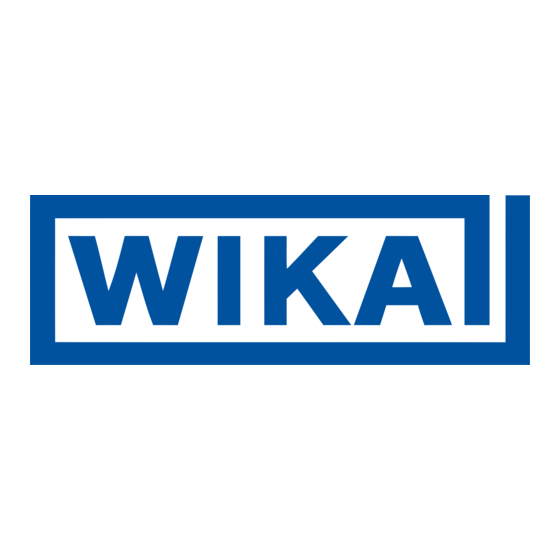
Publicidad
Idiomas disponibles
Idiomas disponibles
Enlaces rápidos
Operating
instructions
Bimetal thermometers
Model 52
Model A52.100
Model R52.100
1. General information
The instrument described in the
■
operating instructions has been
manufactured using state-of-the-art
technology.
All components are subject to
stringent quality and environmental
criteria during production. Our
management systems are certified
to ISO 9001 and ISO 14001.
These operating instructions contain
■
important information on handling
the instrument. Working safely
requires that all safety instructions
and work instructions are observed.
The operating instructions are part
■
of the instrument and must be kept
in the immediate vicinity of the
instrument and readily accessible to
skilled personnel at any time.
Skilled personnel must have
■
carefully read and understood
the operating instructions, prior to
beginning any work.
Subject to technical modifications.
■
Further information:
■
- Internet address: www.wika.de
- Relevant data sheet: TM 52.01
Applied standards
EN 13190: Dial thermometer
Cross-check scope of delivery with
delivery note.
© 2010 WIKA Alexander Wiegand SE & Co. KG
All rights reserved.
Prior to starting any work, read the operating instructions!
Keep for later use!
WIKA Alexander Wiegand SE
& Co. KG
Alexander-Wiegand-Straße 30
63911 Klingenberg • Germany
Tel.
+49 9372 132-0
Fax +49 9372 132-406
info@wika.de
www.wika.de
2. Safety
EN
WARNING!
Before installation,
commissioning and
operation, ensure that
the appropriate instrument has been
selected in terms of measuring
range, design and specific measuring
conditions. Non-observance can result
in serious injury and/or damage to
equipment.
2.1 Intended use
The model 52 bimetal thermometer
is mainly used in the process industry
to monitor process temperatures. It is
suitable for installation in pipes and
tanks. The thermometer offers many
application possibilities for temperature
measurement in liquid and gaseous
media.
The instrument has been designed
and built solely for the intended use
described here and may only be used
accordingly.
WARNING!
For hazardous media such
as oxygen, acetylene,
flammable or toxic gases
or liquids, and refrigeration plants,
compressors, etc., in addition to all
standard regulations, the appropriate
existing codes or regulations must also
be followed.
3. Specifications
For specifications see WIKA data sheet
TM 52.01 and the order documentation.
4. Transport, packaging, storage
4.1 Transport
Check instrument for any damage that
may have been caused by transport.
Obvious damage must be reported
immediately.
4.2 Packaging
Do not remove packaging until just
before mounting. Keep the packaging
as it will provide optimum protection
during transport (e.g. change in
installation site, sending for repair).
4.3 Storage
Permissible conditions at the place
of storage:
Storage temperature: -20 ... 60 °C
Avoid exposure to the following
factors:
Direct sunlight or proximity to hot
■
objects
Mechanical vibration, mechanical
■
shock (shocks during abrupt
positioning)
Soot, vapour, dust, corrosive gases
■
5. Commissioning, operation
When screwing the gauges in, the force
required for this must not be applied
through the case or terminal box, rather
only through the spanner flats provided
for this purpose (using a suitable tool).
Installation with
spanner
Observe the following advice during
sensor installation:
If possible, the entire length of the
■
sensor should be exposed to the
temperature being measured.
In pipelines or other measuring
■
points, the temperature probe must
be positioned as far towards the flow
as possible.
When using thermowells, they must
■
be filled with a thermal contact
medium, in order to reduce the
heat transfer resistance between
the outer wall of the sensor and the
inner wall of the thermowell.
The working temperature of the
■
thermal compound is -40 ... +200 °C.
Before installing the probe, check
whether the probe material used
(specified in the delivery note) is
chemically resistant/neutral to the
medium being measured. This also
applies to thermowells.
6. Maintenance and cleaning
The instrument is maitenance-free.
The indicator should be checked
once or twice every year. For this the
instrument must be disconnected
from the process and checked using a
temperature calibrator.
Clean the instrument with a moist cloth
(soap water).
7. Dismounting, return, disposal
WARNING!
Residual media in
dismounted instruments can
result in a risk to persons,
the environment and equipment. Take
sufficient precautionary measures.
7.1 Dismounting
WARNING!
Risk of burns!
Let the instrument cool
down sufficiently before
dismounting it! When dismounting it,
there is a risk that dangerously hot
pressure media may escape.
7.2 Return
WARNING!
Strictly observe the
following when shipping
the instrument: All
instruments delivered to WIKA must
be free from any kind of hazardous
substances (acids, bases, solutions,
etc.).
When returning the instrument, use
the original packaging or a suitable
transport package.
Information on returns can
be found under the heading
"Service" on our local
website.
7.3 Disposal
Incorrect disposal can put the
environment at risk. Dispose of
instrument components and packaging
materials in an environmentally
compatible way and in accordance with
the country-specific waste disposal
regulations.
Publicidad

Resumen de contenidos para WIKA A52.100
- Página 1 (shocks during abrupt delivery note. transport package. positioning) © 2010 WIKA Alexander Wiegand SE & Co. KG Soot, vapour, dust, corrosive gases ■ Information on returns can All rights reserved. be found under the heading Prior to starting any work, read the operating instructions! 5.
- Página 2 Gegenständen Zur Rücksendung des Gerätes die Mechanische Vibration, mechani- ■ Originalverpackung oder eine geeignete © 2010 WIKA Alexander Wiegand SE & Co. KG scher Schock (hartes Aufstellen) Transportverpackung verwenden. Alle Rechte vorbehalten. Ruß, Dampf, Staub, korrosive Gase ■...
- Página 3 Suie, vapeur, poussière, gaz corrosifs Des informations relatives ■ © 2010 WIKA Alexander Wiegand SE & Co. KG à la procédure de retour de All rights reserved. produit(s) défectueux sont 5. Mise en service, exploitation disponibles sur notre site Lire le mode d‘emploi avant de commencer toute...
- Página 4 (apoyarlo de golpe) Comentarios sobre el Hollín, vapor, polvo, gases corrosivos ■ © 2010 WIKA Alexander Wiegand SE & Co. KG procedimiento de las All rights reserved. devoluciones encuentra en 5. Puesta en servicio, ¡Leer el manual de instrucciones antes de comenzar el apartado “Servicio”...








